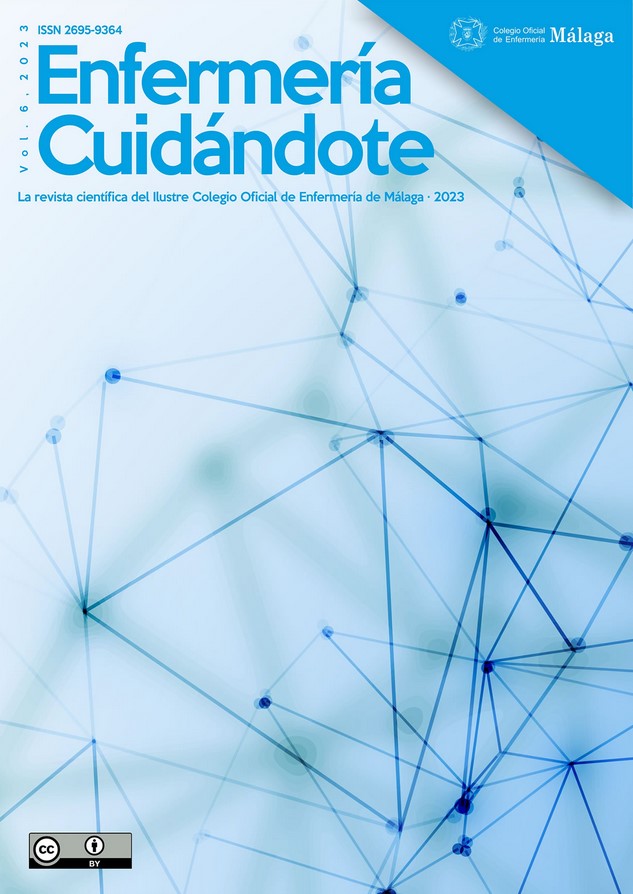Complications in Continuous Renal Replacement Techniques
DOI:
https://doi.org/10.51326/ec.6.1812127Keywords:
Acute Kidney Injury, Complications, Critical Care, Intensive Care Unit, NursingAbstract
Introduction: One of the treatments for acute renal failure is continuous renal replacement techniques, affecting
25% of patients hospitalized in intensive care units. Renal replacement techniques are considered an important
technological advance to treat patients with ARF, allowing greater purifying quality and better control of complications and reducing mortality in these patients.
Objective: For this reason, the main objective of this study is to analyze the most frequent complications of continuous renal replacement techniques, reviewing the scientific evidence from a nursing point of view in patients hospitalized in an intensive care unit.
Method: A bibliographic search was carried out in four Health Sciences databases (PubMed, Elsevier, Ibecs and
UpTodate) from which a significant number of valid articles were obtained for the review.
Results: A total of 2436 articles were obtained, of which, after the exclusion criteria applied, 14 were selected for review.
Conclusions: To guarantee success in continuous renal replacement techniques, it is essential to have a protocol
in which the technique of the procedure carried out by the nursing staff must be collected, as well as the care required by patients, and a nursing team excellently trained in knowledge and skills, to be able to face and anticipate any type of complication in this type of therapy.
Downloads
References
Young MP, You TH. UpToDate. Overview of complications of central venous catheters and their prevention in adults. Waltham (Massachussets): Wolters Kluwers; 2021. Disponible en: https://www.uptodate.com/contents/overview-of-complications-of-central-venous-catheters-and-their-prevention-in-adults [Consultado 05-09-2021]
Manchacoses Primo A, Pitarch Flors R. Técnicas de reemplazo renal continuo. Disponible en: https://www.rccc.eu/ [Consultado 03-10-2021]
Boer W, Van Tornout M, Vander Laenen M, Engelen K, Meex I, Jorens P. Catheter Port Reversal in Citrate Continuous Veno-Venous Hemofiltration. Kidney Int Rep. 2021;6(11):2775-81. https://doi.org/10.1016/j.ekir.2021.08.006
Agarwal R. UpToDate. Dialysis disequilibrium syndrome. Waltham (Massachussets): Wolters Kluwers; 2021. Disponible en: https://www.uptodate.com/contents/dialysis-disequilibrium-syndrome [Consultado 10-01-2022]
Davenport, A. UpToDate. Anticoagulation for continuous renal replacement therapy. Waltham (Massachussets): Wolters Kluwers; 2021. Disponible en: https://www.uptodate.com/contents/anticoagulation-for-continuous-kidney-replacement-therapy [Consultado 15-06-2022]
Golper TA. UpToDate. Renal replacement therapy (dialysis) in acute kidney Injury: Metabolic and hemodynamic considerations. Waltham (Massachussets): Wolters Kluwers; 2021. Disponible en: https://www.uptodate.com/contents/kidney-replacement-therapy-dialysis-in-acute-kidney-injury-metabolic-and-hemodynamic-considerations [Consultado 15-06-2022]
Li Y, Li H, Zhang D. Timing of continuous renal replacement therapy in patients with septic AKI. Medicine. 2019;98(33):e16800. https://doi.org/10.1097%2FMD.0000000000016800
Connor, M. et al. UpToDate. Prescription of continuous renal replacement therapy in acute kidney injury in adults. Waltham (Massachussets): Wolters Kluwers; 2021. Disponible en: https://www.uptodate.com/contents/prescription-of-continuous-renal-replacement-therapy-in-acute-kidney-injury-in-adults. [Consultado 20-02-2022]
Romero García M, de la Cueva-Ariza L, Delgado-Hito P. Actualización en técnicas continuas de reemplazo renal. Enferm Intensiva. 2013;24(3):113-9. https://doi.org/10.1016/j.enfi.2013.01.004
Koska A, Kowalik MM, Lango-Maziarz A, Karolak W, Jagielak D, Lango R. Ionic homeostasis, acid-base balance and the risk of citrate accumulation in patients after cardiovascular surgery treated with continuous veno-venous haemofiltration with post-dilution regional citrate anticoagulation – An observational case-control study. Acta Biochim Pol. 2021; 68(4):695-704. https://doi.org/10.18388/abp.2020_5598
Brandenburger, T, Dimski t, Slowinski T, Kindgen-Milles D. Renal replacement therapy and anticoagulation. Best Pract Res Clin Anaesthesiol. 2017; 31(3):387-401.
https://doi.org/10.1016/j.bpa.2017.08.005
Bianchi NA, Altarelli M, Eckert P, Schneider AG. Complications of Regional Citrate Anticoagulation for Continuous Renal Replacement Therapy: An Observational Study. Blood Purif. 2020; 49(5): 567-75. https://doi.org/10.1159/000506253
Miyatake Y, Makino S, Kubota K, Egi M, Mozobuchi S. Association between Intra-Circuit Activated Clotting Time and Incidence of Bleeding Complications during Continuous Renal Replacement Therapy using Nafamostat Mesilate: a Retrospective Pilot Observational Study. Kobe J Med Sci. 2017. 63(1):30-6. Disponible en: https://www.med.kobe-u.ac.jp/journal/contents/63/E30.pdf [Consultado 15-04-2022]
Schmidt, R.J. Uptodate. Overview of the hemodialysis apparatus. Waltham (Massachussets): Wolters Kluwers; 2021. Disponible en:
https://www.uptodate.com/contents/overview-of-the-hemodialysis-apparatus/print [Consultado 10-11-2021]




















